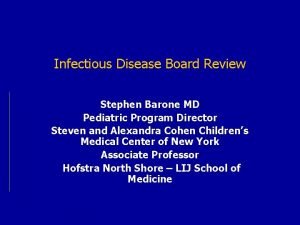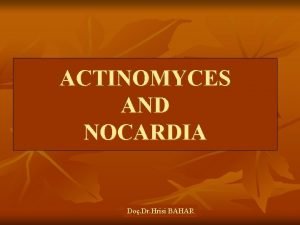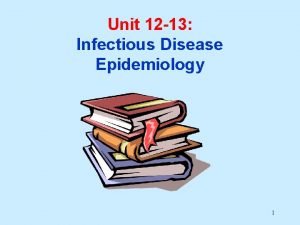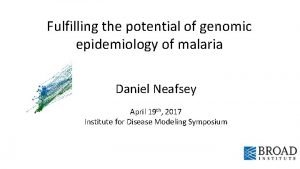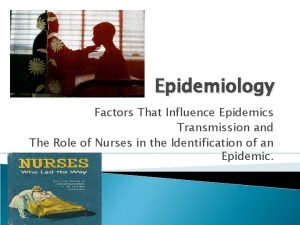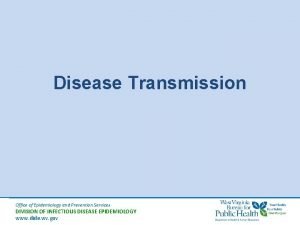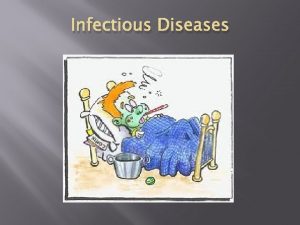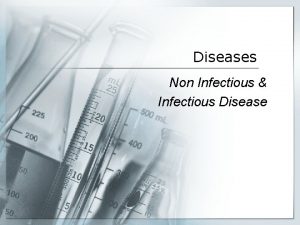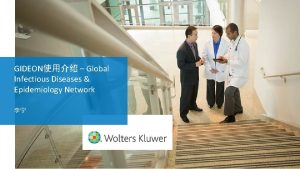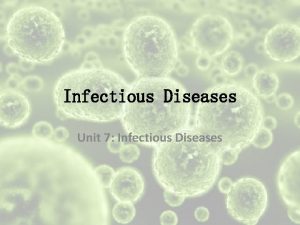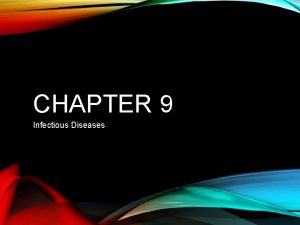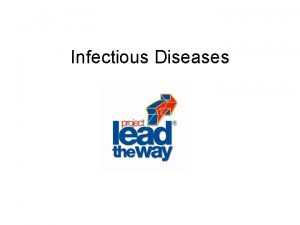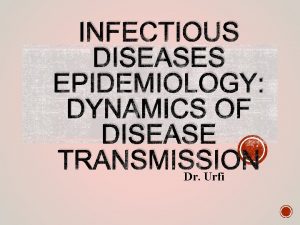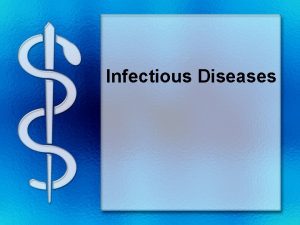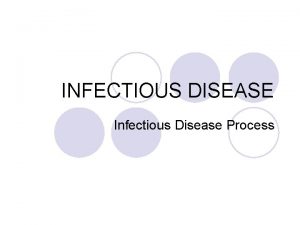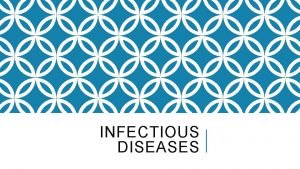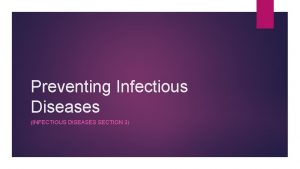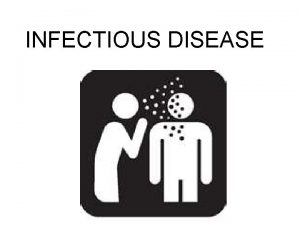Transmission of Infectious Diseases Infectious Disease Epidemiology Section





















- Slides: 21

Transmission of Infectious Diseases Infectious Disease Epidemiology Section Office of Public Health Louisiana Dept of Health & Hospitals 800 -256 -2748 www. infectiousdisease. dhh. louisiana. gov Your taxes at work

Transmission: Source of Infectious Material • • • Blood, internal fluids and genital fluids do contain blood borne pathogens (HIV, HBV, HCV, CMV) Blood: splashed on medical employee. . . Internal Body fluids (cerebrospinal, pericardial, pleural, peritoneal, synovial, amniotic): medical setting. Genital fluids (vaginal, prostatic secretions, semen): sexual contact HBV, HSV to the newborn occurs during delivery. Transplacental transfer of blood: syphilis. Secretions: saliva, nasal discharge, sweat, tear, breast milk Excretions: urine (schistosomiasis, leptospirosis), feces (numerous enteropathogens) Mucosal membranes (nasal, oropharyngeal, rectal, genital): sexual contact, delivery Skin, squames Tissue: Transplant, grafts, blood transfusion, blood components Bites

Droplet A droplet of 100 m 40 m 20 m 10 m 5 -10 m it h ct e r Di 3 ft 5 m Droplet nuclei will fall in 10 seconds 1 minute 4 minutes 20 minutes 30 -45 minutes May be inhaled to alveoli Droplets above 10 m are trapped in the nose and usually do not make it to the bronchi May reach lower respiratory tract Only ones able to reach alveoli

Cough produces good droplet nuclei Cough 1 good cough 465 DN after 30 minutes 228 DN (49%) Speech: count from 1 to 100 1764 DN after 30 minutes 106 DN ( 6%)

Airborne Transmission • • Droplet nuclei = droplets less than 5 µ in diameter • • from evaporation of larger droplets or from direct formation during coughing, speaking, singing Transmission may occur over long distance Without air flow control DN spread throughout the building l l l Transmitted by D. N. Tuberculosis (Infectious) Suspects of TB: request sputum smear Measles Varicella Smallpox (hemorrhagic)

Droplet Transmission • • • Hemophilus influenzae • BACTERIAL RESPIRATORY Infections • Meningococci Pneumococcal infections (invasive, resistant) • Diphtheria, Pertussis, pneumonic plague, Mycoplasma pneumoniae • Strepto pharyngitis, pneumonia, scarlet fever VIRAL RESPIRATORY Infections • • Adenovirus, Influenza, Mumps, Parvovirus, Rubella ANY PAROXYSMAL COUGH (Pertussis? )

Contact Transmission · · · · Gastrointestinal, respiratory, skin, wound infections Colonization with multidrug resistant bacteria Enteric infections, enteroviral infections in infants RSV, parainfluenza, Infectious skin infections: HSV, impetigo, cellulitis, scabies, staphylococcal furunculosis, Viral hemorrhagic conjunctivitis, viral fevers Some respiratory infections, bronchiolitis in infants, children Abscess, draining wound

Droplet & Contact Precautions Most agents transmitted by droplets can also be transmitted by contact

Contact Transmission Activity Pulse, blood pressure Number of Klebsiella on nurse’s hand In Colony Forming Units (CFU) 100 -1, 000 Touching hand 10 - 100 Touch shoulder 7, 0000 Oral temperature Caswell & Phillips 100 – 1, 000 British Med J Nov 1977: 1316 Seroytpe 21 Klebsiella cultured Hands of nurses washed and cultured: NO Klebsiella Patient care Activity

Contact: Fecal Oral Second most important mode of transmission after the respiratory tract • • excreted by the feces transmitted to the oral portal of entry through • • contaminated food, contaminated water, milk, drinks hands flies Site of entry: • • oropharynx for some microorganisms intestinal tract for most viruses. Surviving through the upper GI tract is essential. Viruses with envelopes do not survive exposure to hydrochloric acid in the stomach, bile acids in the duodenum, salts and enzymes of the gut. Small enterovirus without envelope (Norovirus, rotavirus, polio & coxsackie able to resist. Hepatitis A and E also transmitted by fecal oral route.

Contact: Fecal-Oral • • Typhoid fever Shigella Cholera Polio Coxsackie, Echo, Reo Norwalk agent Rotavirus Hepatitis A, Hepatitis E

Transmission Through Skin /Mucous Membrane Transmission through the skin is the third most common mode of transmission of infection. Penetration through the intact skin is unlikely. Break in the skin barrier may result from: • Needle injection, cut during a surgical procedure, accidental cut, crushing injury… • Bite: rabies • Arthropod bite for vector borne infections: malaria, filariasis… Some parasites are able to penetrate directly through the intact skin: larvae of hookworm, cercariae of schistosoma.

Blood & Tissue Exposure: Skin Penetration, Mucosal Membranes • • • Blood borne pathogens ( HBV, HCB, HIV) does not penetrate if blood was splashed exclusively on intact skin. Need injury to the skin: with a hollow bore needle ot other sharp object (lancet, glass, scalpel) contaminated with blood to cause an infection. Solid needle do not carry sufficient quantities of blood to cause an infection ( ± ). Viral titer is best predictor of risk of infection. Mucosal membranes allow BBP penetration. Data from 21 studies worldwide on mucosal membrane exposure of 1107 HCW to HIV showed only one conversion: risk of 0. 09%, 95%CI = 0. 006% to 0. 5%. Risk of infection after percutaneous exposure to blood from infected patients, • HBV 30% • HCV 3% • HIV 0. 3%

Blood & Tissue Exposure: Invasive Procedures • • • Intravascular access Surgery Urinary catetherization Nebulization, Endoscopic procedures Equipment contaminated Contamination during procedure

Gastro. Intestinal Transmission: Food / Animal Host and Contaminated food product • • • Infections transmitted Salmonella Campylobacter E. coli Shiga Toxin producing Vibrio Yersinia Listeria Transmission by food overlaps 3 types of gastrointestinal transmission. • Food from infected animal & improperly prepared: eggs, chicken with Salmonella, listeria in unpasteurized milk • Food contaminated in environment: Vibrio vulnificus or Vibrio cholerae in raw oysters, • Food contaminated during preparation from an infected food item: potato salad contaminated by Salmonella from raw chicken • food contaminated by human source: typhoid fever carrier.

Gastro. Intestinal Transmission: Water / Natural Bacteria or Contamination (Fecal) Gram negative non-fermenters (do not ferment glucose, but oxidize it) Pseudomonas, Stenotrophomonas, Acinetobacter, Flavobacterium and Alcaligenes. Develop in aquatic environments, Simple growth requirements: organic and inorganic substrates from plumbing /storage of water, minute amounts of salts sufficient to support growth. Can reach high concentration in water: Pseudomonas up to 1 million CFU in tap water Can survive for a long time: P. aeruginosa 300 days in water, 150 days on dry Heterotrophic filter paper Plate Count (HPC): Not very pathogenic to humans. 10 CFU/m. L Vibrionaceae (Gram negative rods which are fermenters) without regrowth Vibrios, Aeromonas , Plesiomonas. Normal inhabitants of surface water. Other bacteria: Causes of infections Legionella Mycobacteria.

Sexual transmission (mucous membrane transmission) • • • • • Neisseria gonorrheae, Chlamydia trachomatis Treponema pallidum Hemophilus ducreyi Mycoplasma hominis, Ureaplasma urealyticum Calymnatobacterium granulomatis Shigella spp, Campylobacter spp Group B streptococci Bacterial vaginosis associated bacteria HSV Herpes simplex virus 1 and 2 CMV Cyto megalo virus or herpes virus 5 Hepatitis B virus Human papilloma virus Molluscum contagiosum virus HIV Human immunodeficiency virus 1 and 2 Trichomonas vaginalis Entamoeba histolytica, Giardia lamblia Phtirius pubis Sarcoptes scabei

Sexual transmission (mucous membrane transmission) • • Bacteria and viruses present in the genital fluids and on the mucosal membranes. Transmitted to the mucosal membranes of the partner during sexual acts: membranes involved • • vagina, penis, anus and rectum oropharynx.

Perinatal transmission (mucous membrane transmission) Infections occur when the newborn goes through the birth canal, from the cervix or vagina to the newborn. • Neisseria gonorrheae • Chlamydia trachomatis • HBV • HSV

Transplacental transmission or vertical transmission Microorganisms present in the blood of the mother go through the placenta to infect the fetus. In some cases it is difficult to differentiate between perinatal or transplacental transmission, since both modes of transmission are known to occur. • Syphilis • Toxoplasma • CMV, HBV • HIV • HSV • Rubella, Varicella

Arthropod borne transmission may transmit infections by two mechanisms: • Passive transmission: • • • the insect acts as a live syringe no incubation time, no multiplication while carried by the arthropod not specific, wide variety of microorganisms not very inefficient. Active transmission: • • multiplication of microorganisms in arthropod may be very effective: multiplied 1000 to million requires a period of multiplication in the arthropod very specific: some microrganisms & arthropods Mosquitoes, flies, fleas, true bugs, ticks, lice
 Certain infectious and parasitic diseases
Certain infectious and parasitic diseases Emerging infectious diseases
Emerging infectious diseases Infectious disease quality controls
Infectious disease quality controls Periods of infectious disease
Periods of infectious disease Chapter 26 infectious disease prevention and control
Chapter 26 infectious disease prevention and control Stages of infectious disease
Stages of infectious disease Stridor
Stridor Infectious disease
Infectious disease Hennepin county infectious disease manual
Hennepin county infectious disease manual What is the smallest infectious disease agent
What is the smallest infectious disease agent Infectivity definition
Infectivity definition Puncture resistant container
Puncture resistant container Chapter 19 disease transmission and infection prevention
Chapter 19 disease transmission and infection prevention Chapter 19 disease transmission and infection prevention
Chapter 19 disease transmission and infection prevention Disease transmission
Disease transmission Factors that influence disease transmission
Factors that influence disease transmission Disease transmission
Disease transmission Section 19-3 diseases caused by bacteria and viruses
Section 19-3 diseases caused by bacteria and viruses Communicable disease and non communicable disease
Communicable disease and non communicable disease Ukuran asosiasi epidemiologi
Ukuran asosiasi epidemiologi Advantages and disadvantages of nutritional epidemiology
Advantages and disadvantages of nutritional epidemiology Logistic regression epidemiology
Logistic regression epidemiology






